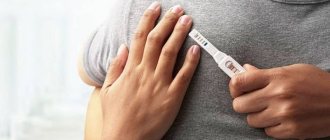Ovulation and timing of fertilization
OVULATION (from Latin ovum - egg) - the release of a mature egg capable of fertilization from the ovarian follicle into the abdominal cavity; stage of the menstrual cycle (ovarian cycle). Ovulation in women of childbearing age occurs periodically (every 21-35 days). The frequency of ovulation is regulated by neurohumoral mechanisms, mainly by gonadotropic hormones of the anterior pituitary gland and ovarian follicular hormone. Ovulation is promoted by the accumulation of follicular fluid and the thinning of the ovarian tissue located above the protruding pole of the follicle. of ovulation, which is constant for every woman, undergoes changes within 3 months after an abortion, within a year after childbirth, and also after 40 years, when the body prepares for the premenopausal period. Ovulation stops with the onset of pregnancy and after the cessation of menstrual function. Establishing the date of ovulation is important when choosing the most effective time for fertilization, artificial insemination and in vitro fertilization.
Signs of ovulation
Subjective signs of ovulation may include short-term pain in the lower abdomen. Objective signs of ovulation are an increase in mucous discharge from the vagina and a decrease in rectal (basal) temperature on the day of ovulation with an increase in it the next day, an increase in the content of progesterone in the blood plasma, etc. Ovulation are caused by dysfunction of the hypothalamic-pituitary-ovarian system and can be caused by inflammation genitalia, dysfunction of the adrenal cortex or thyroid gland, systemic diseases, tumors of the pituitary gland and hypothalamus, stressful situations. The absence of ovulation during childbearing age (anovulation) is manifested by a disturbance in the rhythm of menstruation such as oligomenorrhea (menstruation lasting 1-2 days), amenorrhea, and dysfunctional uterine bleeding. Lack of ovulation (anovulation) is always the cause of a woman’s infertility. Methods for restoring ovulation are determined by the cause that caused anovulation and require a visit to a gynecologist and special treatment.
Male reproductive system
In fact, infertility occurs equally in both women and men. Male and female factors account for approximately two-thirds of all causes of infertility. The remaining third is either combined or unclear infertility. The following is information that may shed light on the working principle of these special male “swimmers” - sperm.
As in the female reproductive system, the normal anatomy of the male reproductive organs and balanced hormone production play an important role in pregnancy. The same hormones that regulate female reproductive functions also regulate sperm production in men. FSH stimulates sperm production, and LH stimulates the synthesis of testosterone, which helps maintain sperm production.
A sperm cell is a highly specialized cell that consists of a head, which stores chromosomes, and a tail, which allows for movement. Sperm are produced in the testicles, located in the scrotum. It maintains a lower temperature than the general body temperature, which ensures the normal development of sperm. The sperm then travel to the epididymis, an organ that stores and nourishes the sperm as they mature. During sexual intercourse, sperm from the epididymis together with fluid from the seminal vesicles and prostate gland form sperm. This fluid enters the woman's vagina. Sperm can live in the female reproductive tract for 48 to 72 hours, retaining the ability to fertilize an egg.
At the Center for Assisted Reproductive Technologies you can get tested for male infertility and get a spermogram analysis.
Ovulation and contraception
Some women experience peak sexual arousal around the days of ovulation . However, the use of a physiological method of contraception from pregnancy, based on sexual abstinence during ovulation , is especially difficult for young spouses, whose frequency of sexual intercourse reaches a fairly high level. In addition, with strong love excitement and nervous stress, additional ovulation can occur (especially with episodic, irregular intercourse) and then not one, but two eggs mature in one menstrual cycle. This should be kept in mind when choosing one or another method of contraception.
Hormones involved in the regulation of the menstrual cycle
Hormonal regulation of the menstrual cycle is carried out through the interdependent synthesis of hormones at all levels of cycle regulation.
Hormones of the menstrual cycle:
- The hypothalamus secretes: gonadoliberins and statins. Liberins activate the synthesis of pituitary hormones, while statins, on the contrary, inhibit their production.
- Pituitary. The hormone FSH (follicle-stimulating hormone) stimulates the growth of follicles in the ovary. LH (Luteinizing hormone).
- The ovaries, under the “tropic” influence of the pituitary gland, secrete testosterone, estrogens and progesterone.
Hormonal regulation of the menstrual cycle is a codependent system in which the incorrect functioning of one link disrupts the functioning of the entire system.
Timing of ovulation
It should be noted that different women have a noticeable difference in the timing of ovulation . And even for the same woman, the exact timing of the onset varies from month to month. Some women have extremely irregular cycles. In other cases, cycles may be longer or shorter than the average of 14 days. In rare cases, it happens that in women with a very short cycle, ovulation occurs around the end of the menstrual bleeding period, but in most cases, ovulation occurs quite regularly.
If for one reason or another ovulation does not occur, the endometrial layer in the uterus is thrown out during menstruation. If the fusion of the egg and sperm has occurred, then the cytoplasm of the egg begins to vibrate very strongly, as if the egg is experiencing an orgasm. Sperm penetration is the final stages of egg maturation. All that remains of the sperm is its nucleus, where 23 chromosomes are tightly packed (half the set of a normal cell). The sperm nucleus now quickly approaches the egg nucleus, which also contains 23 chromosomes. The two nuclei slowly touch. Their shells dissolve and their fusion occurs, as a result of which they are divided into pairs and form 46 chromosomes. Of the 23 chromosomes of the sperm, 22 are completely similar to the chromosomes of the egg. They determine all physical characteristics of a person except gender. The remaining pair from the egg always contains an X chromosome, and from the sperm there may be an X or Y chromosome. Thus, if there are 2 XX chromosomes in this set, then a girl will be born, if XY, then a boy.
Ways to regulate the menstrual cycle
Hormonal regulation of the ovarian-menstrual cycle is a complex and multi-stage process. However, the achievements of modern medicine and gynecology in particular make it possible to regulate this complex cascade of reactions. This became possible through the use of exogenous hormonal agents.
Mild and safe regulation of the normal menstrual cycle can be achieved through the use of combined oral contraceptives (COCs). In their production, a combination of estrogen and progestogen components is used. It is due to the introduction of hormones into the body from the outside that the former “understands” that he no longer needs to direct his forces to the synthesis of sex steroids and the active work of the ovaries stops. These same COCs provide the supply of hormones to the ovaries. And in the ovaries, therefore, neither growth nor maturation of follicles occurs, which means ovulation does not occur. That is, there is no possibility of pregnancy while taking such drugs. After their cancellation, the ovarian-menstrual cycle is restored immediately with the presence of not only ovulation. After all, when COCs are discontinued, the so-called phenomenon of “superovulation” occurs - the maturation of not one, but several follicles. This increases the chances of pregnancy.
Ovulation, conception and gender of the child
Research conducted at the National Institute of Environmental Health Sciences (North Carolina) has shown that not only the actual conception of a child, but also its gender depends on the time of conception in relation to the time of ovulation .
The chance of conception is highest on the day of ovulation and is estimated at approximately 33%. A high probability is also noted on the day before ovulation - 31%, two days before it - 27%. Five days before ovulation the chance of conception is estimated to be 10%, four days before ovulation is 14% and three days before ovulation is 16%. Six days before ovulation and the day after ovulation, the likelihood of conception during sexual intercourse is very low.
If we consider that the average “life expectancy” of sperm is 2-3 days (in rare cases it reaches 5-7 days), and the female egg remains viable for about 12-24 hours, then the maximum duration of the “dangerous” period is 6- 9 days and the “dangerous” period correspond to the phase of slow increase (6-7 days) and rapid decline (1-2 days) before and after the day of ovulation , respectively. Ovulation , as noted above, divides the menstrual cycle into two phases: the follicle maturation phase, which with an average cycle duration is 10-16 days and the luteal phase (corpus luteum phase), which is stable, independent of the duration of the menstrual cycle and is 12- 16 days. The corpus luteum phase refers to the period of absolute infertility; it begins 1-2 days after ovulation and ends with the onset of a new menstruation.
Levels of regulation of the menstrual cycle
Regulation of a woman's cycle and levels of the menstrual cycle is a multifaceted process that ensures the physiological and stable functioning of the female reproductive system. Failure of at least one element of the regulation level cascades into an imbalance in the work of the remaining links in this chain.
Levels and pattern of regulation of the menstrual cycle.
Regulation of the menstrual cycle is an interdependent system. Five levels are involved in the regulation of the menstrual cycle:
- Cortex. The regulatory cascade begins with the brain.
- Hypothalamus. This is the part of the brain that secretes liberins and statins, hormones that stimulate or inhibit the production of hormones at the next level of regulation - the pituitary gland.
- Pituitary. This is the section of the brain in which all tropic hormones are produced, not only for the reproductive system. It is these hormones that force the ovaries to work and stimulate the synthesis of sex hormones directly by the female appendages of the uterus. A hormone that stimulates the growth and maturation of follicles (FSH) and LH.
- Ovaries. A paired organ in which, under the stimulating influence of tropic hormones of the pituitary gland, follicles grow and mature. It is in the ovary that sex steroids are produced. They, in turn, exert their multifaceted influence both on the uterus, directly on the endometrium, and on the target organs of the whole organism.
Phases of the menstrual cycle: hormones
At the ovarian level, two phases can be distinguished:
- Follicular phase. The follicular phase is characterized by the growth and maturation of follicles. During this period, there is progressive production of estrogen. In the endometrium, proliferative changes occur under the influence of the specified hormonal levels. The midpoint between these two phases is ovulation - the release of an egg from a mature follicle. In place of the burst follicle, a corpus luteum is formed, which ensures the functioning of the next phase - the luteal phase.
- Luteal phase. In the luteal phase, active secretion of progesterone by the corpus luteum occurs, and characteristic changes occur at the endometrial level.
The immediate target organs in the reproductive system are the uterus and endometrium, fallopian tubes. The most significant changes occur under the regulation of such a complex hormonal cascade precisely in the uterine mucosa.
At the endometrial level, several hormonally dependent phases can be distinguished:
- Desquamation phase. It starts from the first day of menstruation. Characterized by rejection of the functional layer of the uterine mucosa. Clinically, this is manifested by bloody discharge from the genital tract with fragments of the endometrium. Occurs when pregnancy has not occurred and hormone levels have dropped significantly.
- Regeneration phase. Against the background of growing follicles, a kind of “healing” of the uterine mucosa occurs, the growth of a new layer from the basal layer of the endometrium.
- Proliferative phase. The increasing level of estrogen ensures the active growth of the functional layer, which actively increases in thickness.
- Secretion. This phase is controlled primarily by progesterone. During its course, secretory changes occur in the endometrium (active accumulation of glycogen in cells). This is precisely what is necessary for normal implantation and functioning of the embryo in the early periods of its intrauterine development.
If pregnancy does not occur, then the hormones drop at the end of the cycle, the secretion phase moves into the next desquamation phase, and the cycle repeats again. Hormones are produced again in a cycle.
Ovulation tests
Tests show a surge in luteinizing hormone, which triggers the ovulation mechanism. The test is considered positive if the test strip becomes brighter than the control line. The method is inaccurate, since a positive result may take several days. But its advantage is its low cost and the ability to perform it at home.
With a regular cycle, it is recommended to carry out tests in the middle. For example, the length of the cycle is 28 days, tests need to be done from days 12 to 16 in order to catch the moment of ovulation. For some girls it happens early or late, so tests are best combined with other methods.
Increased physical activity
Intense physical activity and sports do not always benefit a woman. Especially with excessive enthusiasm. As a result, this is another reason for the lack of ovulation. Of course, you should not abandon such activities. You just need to do them in moderation, without overloading, unless, of course, you are planning a pregnancy. This mainly applies to women with low body weight and low levels of fatty tissue. This includes those who do running, swimming, ballet, etc.
They usually have in combination:
- physical stress of the body;
- emotional stress;
- low fat ratio;
- changes in thyroid function.
All these factors explain why there is no ovulation and no pregnancy. Problems with ovulation are often observed among female athletes, especially during the period of intensive preparation for competitions. When a woman is planning a pregnancy, she should reconsider her lifestyle. This does not mean giving up sports completely. Moderate-intensity training can be continued. But participation in competitions is not only physical stress, but also psychological stress.
Don't self-medicate
Contact us for qualified help
Symptoms and diagnosis
It can be difficult to guess from clinical symptoms that the egg is not maturing. Typically, such disorders are identified using ultrasound assessment of the condition of the endometrium and ovaries. On the 8-9th day of the menstrual cycle, a dominant follicle should normally be determined, which increases by 2-3 mm every day. On the eve of ovulation, its size should reach 18-22 mm. The granulosa cells of such a follicle produce sex hormones, the predominant of which in the first phase of the cycle is estradiol. It causes proliferation of the endometrium, as a result of which the mucosa thickens and has a typical three-layer structure. Closer to ovulation, the growth of glands begins - a secretory transformation of the endometrium, which is well determined using ultrasound.
The following symptoms help to suspect impaired egg maturation:
- insufficient thickness of the endometrium; absence of a three-layer structure and preovulatory changes; absence of a dominant follicle or its small size on the eve of ovulation.
Additionally, to assess folliculogenesis, the concentration of estradiol and luteinizing hormone in the blood can be determined.
How does an egg mature?
Ovulation is an endocrine-mediated process of follicular rupture that occurs approximately 35-40 hours after the rise in luteinizing hormone (LH) levels. The egg must be released into the abdominal cavity and then enter the fallopian tube.
A rise in the level of luteinizing hormone initiates the final maturation of the female reproductive cell, which will be ready to meet the sperm. At the same time, under the influence of LH, the synthesis of prostaglandins is activated. These substances promote the separation of the egg-bearing tubercle from the follicle wall, and also contribute to the dissolution of the follicle membrane and its rupture. If this does not happen, then empty follicle syndrome develops. In this case, during IVF after follicle puncture, it is not possible to obtain an egg.
Normally, during the ovulation phase, the ovary should move closer to the fimbriae of the fallopian tube so that the oocyte can easily enter there. This process can be disrupted by adhesions and scars, cysts, endometrioid lesions due to mechanical pressure or through impaired motility of the fallopian tube.
Thus, the process of follicle maturation is very complex. And only its competent modeling, taking into account physiological characteristics, can lead to the desired results in the treatment of endocrine infertility.
A personalized approach to each woman at the SM-Clinic reproductive health center allows us to achieve the best therapeutic results. Doctors examine each case down to the smallest detail, answer the question of whether the egg may not mature, and identify the factors that contribute to this in order to correct existing disorders.
Change of scenery
If a woman does not ovulate, this may be due to travel or moving to a new place of residence. This reason is one of the most common factors that provoke lack of ovulation. The body can regard the emotional outburst experienced as stress. This is caused by a sharp change in climate and habitual rhythm of life. Disruption of the body's biological clock does not go away without leaving a trace. It takes time to adapt. This is especially pronounced when there is a sharp change in time or climate zone.
But this doesn't happen to everyone. Sometimes, with a sudden change of situation, for example, while on a business trip, there are no special disturbances, but when returning home, malaise appears; a cold may appear even in the summer, an exacerbation of chronic diseases and the absence or delay of menstruation.
Women whose profession involves constant travel - flight attendants, conductors - also experience such pathological conditions. The body can adapt over time and the menstrual cycle will improve. But sometimes adaptive abilities are reduced and in order not to harm your health you have to change your specialty. In such cases, most often a woman’s monthly cycle lengthens due to delayed ovulation. During such a period, menstruation and ovulation may be absent altogether.
Reduced number of ovulations due to menopause
Lack of ovulation is also observed during menopause. The reduction in their number begins at about 30 years of age. For some women earlier, for others later. If girls have anovulatory cycles 1-2 times a year, then for older women - almost every month. And sometimes more often. It is for this reason that it becomes more difficult to get pregnant as you age, and why during this period, due to the lack of ovulation, you sometimes do not have regular periods.
Anovulation prevents pregnancy. To find out the cause, you need to undergo a full examination by a gynecologist. If no pathologies are found in the reproductive organs, the endocrine system and other possible causes of anovulation should be checked.
Change in body weight
The reasons why there is no ovulation may be related to weight loss. The fact is that the female body needs fat to ensure normal physiological processes. It is a natural estrogen (female hormone) store and androgen converter. The latter is an important element that supports optimal ovulation. In women who are extremely thin, menstruation may disappear altogether. Especially if the process is complemented by a lack of appetite due to stress.
Normally, a woman's body should contain at least 18-20 percent body fat of the total weight.
Otherwise, problems arise and there is no ovulation, why? Mainly due to the fact that the body is not able to reach the level of estrogen required for the maturation of eggs and their release from the ovaries.
Advantages of treatment at the SM-Clinic Reproductive Health Center
In the multidisciplinary holding center for reproductive health "SM-Clinic", consultations are conducted not only by gynecologists, but also by doctors of other specialties, whose task is to “tune” the woman’s body to the correct functioning and successful implementation of the reproductive function. Diagnostics are performed using expert-class equipment, which allows us to identify even minor deviations in the functional state of organs. In our own laboratory, we evaluate various indicators that reflect the state and functioning of the reproductive system.
The SM-Clinic Reproductive Health Center is a center where qualified specialists will help assess your fertility and, in case of existing disorders, select the most optimal method of correction.
Chronic stress
Constant and increased stress is one of the significant reasons why there is no ovulation. Nervous stress, mental overload and chronic stress are among the most common reasons for delaying this process. Excessive shock can become a stopping mechanism for ovulation. Moreover, with its complete absence for a very long period.
The regulation of the reproductive function of the body is called neurohumoral. This suggests that the brain controls the secretion of hormonal substances. Stress and overexertion create pathological foci in the brain tissue that affect the production of gonadotropic hormones. Therefore, treatment of this type of disorder can be difficult and sometimes lengthy. If external factors are not eliminated in a timely manner, the process may deepen and then not only will pregnancy not occur, but diseases of other organs may also develop.
Stress ulcers most often appear in the stomach; they can lead to bleeding, disruption of the supply of nutrients to the body, and as a result, decreased immunity, changes in the blood coagulation system, and much more.










